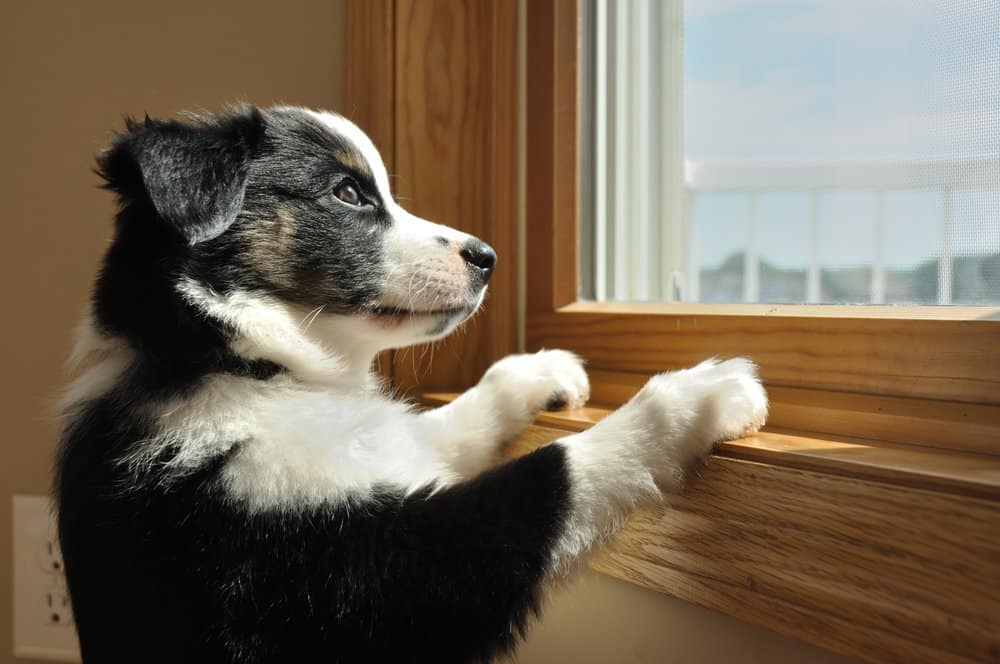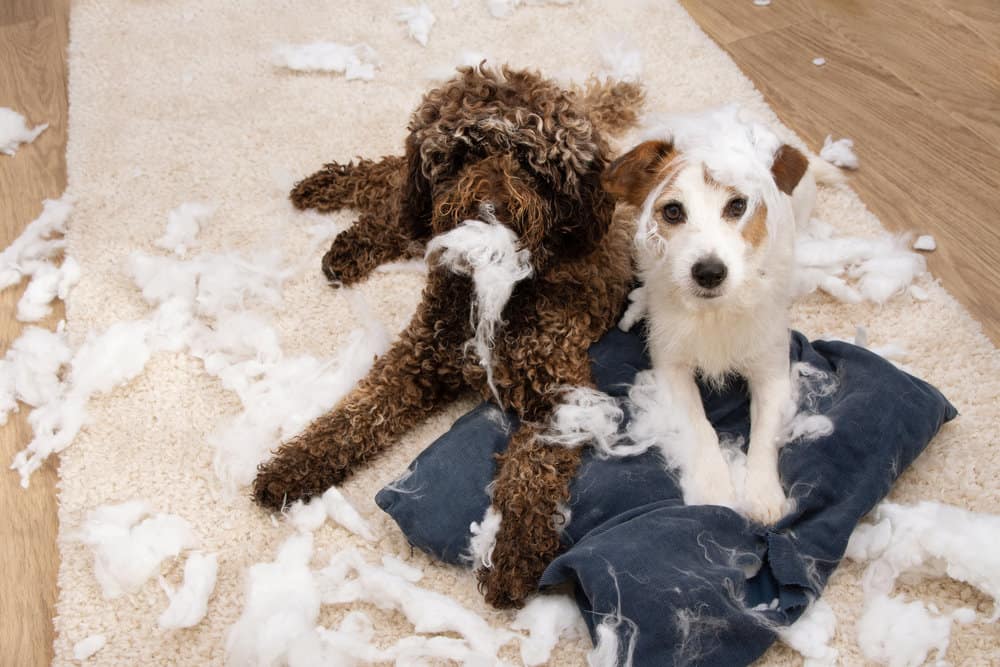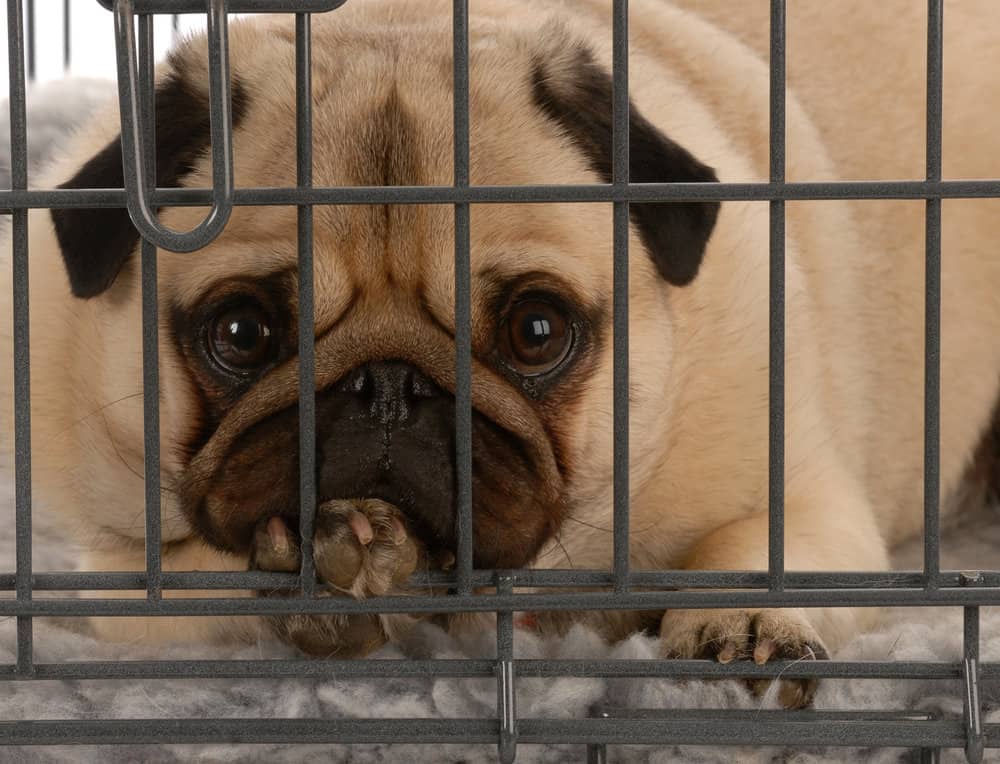Leaving a 6-week-old puppy home alone is wrong because this little creature isn’t trained enough to be on its own.
At this age, the puppy needs to be with its mother, and removing it too soon will lead to behavioral problems like separation anxiety and aggression.
Moreover, a puppy can hold it for about one hour per month of age, so if you choose to leave it alone at this age, you’re likely to end up with a mess and a confused puppy.
What is the Maximum Time to Leave a 6-Week-Old Puppy Home Alone?

When you have no other choice, you can leave your 6-week-old puppy home alone for one hour or less because this is the maximum time it can hold its pee.
Yet, this isn’t recommended because your little puppy needs supervision or it will suffer from separation anxiety. So, you should either leave it with its mother or be around to keep an eye on it.
The good news is that puppies sleep a lot. So, if your puppy is already sleeping, you can have an hour or so for a quick errand.
Puppies need breaks much more often than adult dogs, so you’ll need to be around to take it for a walk. However, even if your puppy can hold it for an hour, there are tips you need to follow to ensure that it can be left alone with no issues.
How Long Can You Leave a Dog Before it Needs to Pee?
Generally, a puppy must urinate between three and five times a day. The younger the puppy, the more it needs to pee.
Here are the time limits for leaving your puppy alone.
- 6 weeks or younger: less than one hour.
- Between 6 and 10 weeks: one hour.
- Between 10 and 12 weeks: two hours.
- Between 3 and 6 months: three hours to six hours, following the one hour per month rule.
- After 6 months: up to six hours. The dog has the ability to hold its pee as much as an adult dog.
Helpful Dog Training Resource:
For help with training your dog, you should take a look at The Online Dog Trainer by Doggy Dan. Doggy Dan is an expert Dog Trainer based in New Zealand. His online resource contains Hundreds of Excellent Dog Training Videos that will take you step-by-step through the process of developing a healthy, happy well-behaved dog.
What Happens When You Leave a Puppy Alone for Too Long?
Without proper training, your puppy can suffer emotionally and physically when you leave it alone for too long.
Physical Issues
When the dog doesn’t pee often, it can suffer from some medical issues like kidney stones and urinary tract infections.
When left untreated, your dog can suffer from blood poisoning and infertility, and the condition might even be fatal.
The vet will examine your dog and administer antibiotics to treat this condition.
Emotional Issues
Neglected dogs usually suffer from separation anxiety when left alone for long periods. Separation anxiety leads to several behavioral problems.

- Constant howling, barking, or whining, especially when you’re not home.
- Chewing on furniture pieces, curtains, and rugs when it’s left outside the crate.
- Licking and chewing its own paws to the point of causing infection.
- Eliminating in the crate, although it knows that it shouldn’t.
- Excessive scratching of doors, trying to leave the house.
- Digging and scratching the floor.
- Following you around excessively once you’re home.
- Not following your orders if you ask the dog to leave the room or not to get on the bed.
- Becoming visibly upset or crying when it notices that you’re about to leave the house.
How Can You Teach Your Puppy to Be Alone?
You can’t just bring a puppy or adult dog home and leave it alone with no proper training.
Your puppy was probably never alone before you brought it home because it was living with its mother and littermates. This is why you should start crate training to teach your puppy to be alone while you’re at home.
Proper training starts by making the crate a safe spot for your puppy. Here are some rules to follow to make crate time more enjoyable for your puppy.
- Make sure that you’ve picked a special crate or exercise pen for your puppy. It should be safe and free from sharp objects that might hurt your dog.
- Start with playing with your puppy near the crate, and then give it 10 minutes of playtime inside.
- Feed your dog and play with it while it’s still in the crate.
- Avoid punishing your puppy in the crate so it doesn’t associate it with a negative experience.
- Provide special toys your dog can only use when in the crate.
- If your dog seems too anxious, use a white noise machine to help it relax.
- Leave some items in the crate that make the puppy easily adjust to your absence, like an old t-shirt.
- Provide the puppy with a comfortable bed or mattress where it can sleep comfortably.
- Add some pads to absorb the mess if an accident happens.
- Teach your puppy the importance of quite a time. For example, while playing, interrupt play time with quiet breaks, or use this time to provide the dog with food, which it can eat alone.
Helpful Dog Health Resource:
Note: Our Health is #1 Priority. It should be no different for your dog. But you need to help him. The Ultimate Guide to Dog Health is the answer. This handy guide will help you recognize the symptoms of the health problems above. Get the knowledge to stay ahead of these terrible issues that can rob your lovely dog from vigor and life. Help your friend make it to 14 yrs+ without pain and suffering.
Maximum Crate Time According to Age

After crate training your dog, you still can’t leave it for hours in the crate. However, you need to make sure that all its needs are met before leaving it in the crate.
Dogs are social beings, and they need social interaction with humans and other dogs to stay healthy and happy. So here are the maximum time limits for leaving your dog in the crate after successful crate training.
- Below 10 weeks: between 30 and 60 minutes.
- Between 11 and 14 weeks: between 1 and 3 hours.
- Between 15 and 16 weeks: up to 4 hours.
- After 17 weeks: up to 5 hours.
Nevertheless, it’s important to know that leaving your dog alone in the crate for 5 hours every single day isn’t healthy. By that time, the dog should be trained to move around the house without causing a mess.
You can dog-proof some areas in the house to keep the dog away. However, you shouldn’t confine it to the crate for long periods.
You’ll have to come home during the day for a short break to take your dog out if you have to work. You can also hire a dog sitter to check on your dog and play with it while you’re away from home.

Paul has been creating content for the dog niche for many years. The information he shares comes his first hand experience growing up in dog lovers household and then owning multiple dog breeds of his own as an adult. Paul enjoys doing the hard research to collect, analyze and present our dogtemperament.com readers with the best answers to their questions.